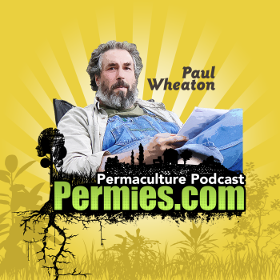 Listen Online
Listen Online  Download
Download  Get all of the podcasts in convenient, giant zip files
Get all of the podcasts in convenient, giant zip files  Subscribe on iTunes
Subscribe on iTunes Summary
Credit:
Summary
Credit: Summary prepared by Marianne Cooper
Rob's published
15 books on a variety of building techniques and this conversation focuses on how to get to the point of obtaining land, planning, building for now and for the future and doing it debt free.
Paul begins with an overview of some of the work Rob's done in the past. They touch on stone moving, heating and cooling structures via
earth tubes, using thermal mass, insulations, storing heat (& "cool heat") building material both interior & exterior, air movement and direct combustion for stove efficiency. They talk further about the efficiencies and challenges of cordwood structures and the DVD/book of Rob's. Rob notes some of the advantages of not needing air exchangers with
cordwood structures because of the nature of logs aka checks/cracks. He notes the lack of efficiencies if building with green wood. There's further conversation about
timberframed/cob buildings as well as lime putty & mortar.
They move on to the economics of a
mortgage free lifestyle and the deliberate path needed to get there. There are 5 "E"s associated with this method, 4 of which are mentioned during the conversation:
1. Economics
2. Ease of construction
3. Environmental advantage
4.
Energy efficiency
Rob lays out the steps he feels will get anyone mortgage free:
1.
Grubstake aka keep your day job, save, reduce expenditures, save, change from a consumer to a conservative and save some more. Paul notes this will be different for everyone; what some people find a necessity, other can do without.
2. Find land. They both agree with the importance of having a list of priorities, budget, know how much work you are willing to do to "reclaim" land. Fire kill, abandoned gravel pits and other marginal land will always be cheaper or even free.
3. Build a temp. shelter, start in the spring as this shelter should be "home" for 3 - 10 months only. This will be used during construction of a permanent shelter and can later be converted for an alternative use like a shed, smoke house etc.
4. Build your home. You need some DIY knowledge to conserve costs but always ask/hire professionals/knowledgeable people for things you are unfamiliar with like electrical. Both Paul and Rob noted the importance of starting small with a good plan that will allow further additions. They note that it's easier to add on, should you want additional space and starting small and manageable is paramount. The key is to build what you can afford without debt and expand as your needs and budget allow. This approach is most apparent in the
"Tiny House" movement and all of its merits.
Rob finishes by noting that with patience and a definitive plan, mortgage free living is obtainable and extremely satisfying.
Relevant Links
Podcast 059 - Early Retirement Extreme
Support the Empire
Help support the empire and get all of the podcasts in bundles
here
To support production of these podcasts, make a donation
here at Paul's Patreon page.













